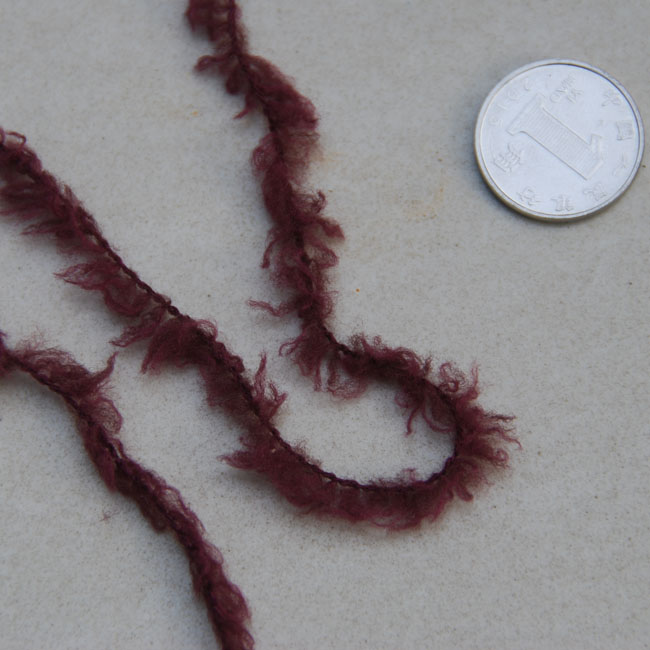The application of fancy yarn in woven fabrics
Fancy yarn is a general term for fancy yarn and fancy yarn, which refers to yarn produced by special processing techniques that has irregular or regular changes in appearance, shape, and structure, and is different from general single yarn and stranded yarn. In practical production, people tend to refer to single stranded fancy yarn as fancy yarn and combined fancy yarn as fancy yarn. As a common branch of yarn, fancy yarn has been widely used in various fields of the textile industry due to its novel structure, colorful appearance, and easy emergence of new functions.
The classification of fancy yarns includes: knot yarn, belly yarn, corrugated yarn, looped yarn, bamboo yarn, wrapped yarn, Icelandic wool yarn, brushed yarn, braided yarn
The use of fancy yarns in woven fabrics
There are two ways to use fancy threads in the weaving process of woven fabrics. One type is to use fancy yarns for both warp and weft, or fancy yarns for both warp and weft, which are more commonly used in weaving thick, stiff, and coarse fabrics. Especially some irregular fancy thread contours make the irregular distribution of the fabric surface more stylish, such as cotton and linen yarn woven bamboo yarn fabric: the warp yarn is 133Tex pure ramie bamboo yarn, and the weft yarn is 54.4Tex * 2 gray linen cotton yarn, arranged in a plain weave. Generally speaking, there are fewer cases where fancy threads are used for both warp and weft. Due to the many decorations on the fabric, there is no sense of coarseness or conciseness, and instead, it is too messy, resulting in problems such as heavy fabric and low weaving power, and an increase in production costs. The second method is to place fancy yarns and general yarns in a certain proportion in warp and weft yarns, or warp and weft yarns, adjust the warp and weft density, and then dot the fancy yarns into the fabric to give it a special appearance and outstanding wearability. Following the principle of "less but more precise", it plays an outstanding three-dimensional effect without increasing the cost too much. The weaving process is also relatively easy, and the production power advances. For example, for real silk knots, the warp yarn is 23dtex * 3 factory yarn, the weft yarn is 23dtex * 4 factory yarn with 8 twists/cm, and the weft yarn (23dtex * 3 23dtex * 3 color yarn) is 4.65 twists/cm. The weft yarn and weft yarn are placed more efficiently than the weft yarn and weft yarn. The arrangement is to weave small jacquard patterns, with a grid effect consisting of longitudinal stripes and knot lines on the surface.

The methods for planning fabrics with fancy yarns include: using fancy yarns with different functions and thicknesses from other warp and weft materials to create appearance effects such as stripes, grids, dots, gloss, and concave convex stripes on the fabric surface; The use of warp and weft color lines and fancy lines can create a three-dimensional effect with varied colors; Using changes in the ratio of warp or weft to fancy threads to create a common appearance; Use different latitude and longitude densities for allocation; Using the arrangement of different fabrics and the blending of fancy threads; Utilizing various post-processing and dyeing characteristics to enhance the functionality and quality of fancy yarn fabrics. It is worth noting that in order to reflect the color effect, structural effect, and special effect of the fancy yarn on the appearance of the final fabric, attention should be paid to the material blending, fancy type, and fabric use of the fabric.
After years of effort, the use of fancy yarns in the development of woven fabric products has made significant progress. Using fancy threads on top of spun woolen fabrics not only maintains the high-end feel of the fabric, but also adds a touch of elegance to its appearance. Using the same woolen fabric can produce very popular woolen products. Fancy yarns are widely used in yarn dyed products, including thick, medium, and thin fabrics. In addition, the use of imitation natural fiber products and fancy gauze has become increasingly sophisticated.
Article source: Fancy Thread Manufacturer
-
05-27
The reason why fabrics containing spandex are prone to yellowing
Spandex is a commonly used fiber variety in our daily lives, characterized by good elasticity, low fineness, high elastic modulus (cracking elongation can reach 400-800), and low specific gravity. Spa
-
04-24
Colored non dyed nylon with synthetic fiber raw material
The current conventional fiber coloring mostly uses yarn dyeing method, which has long process, high loss, high cost, and the product has color difference and low color wash fastness. Yarn is prone to
-
03-26
What are the characteristics of non dyed spandex?
Non dyed spandex has also been widely used in recent years. Non dyed spandex fiber can be blended with fibers such as nylon, polyester, acrylic, cotton, wool, etc., which can give fabrics excellent el
-
02-24
The influence of yarn structure on fabrics
The basic characteristics of yarn include its appearance and shape, twisting characteristics, fiber transfer and distribution characteristics in the yarn, as well as the surface fuzz and internal loos
